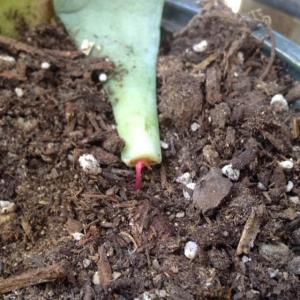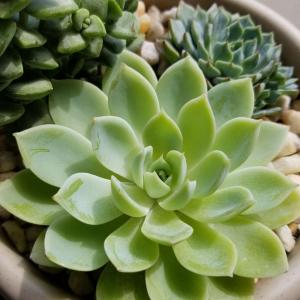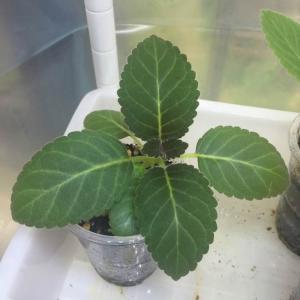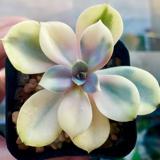文章
Dummer. ゛☀
2017年09月26日

Scientific Name
Tillandsia harrisii Ehlers

Common Names
Air Plant
Scientific Classification
Family: Bromeliaceae
Subfamily: Tillandsioideae
Genus: Tillandsia

Flower
Color: Orange to red floral bracts and blue-violet petals
Bloom Time: Indeterminate
Description
Tillandsia harrisii is a very unique looking air plant up to 8 inches (20 cm) tall. It has a relatively long stem, with the leaves usually directed to one side, and curled in a dense rosette. The inflorescence is comprised of five to nine spirally arranged flowers, with orange to red floral bracts and blue-violet petals.
Hardiness
USDA hardiness zone 9b to 11b: from 25 °F (−3.9 °C) to 50 °F (+10 °C).

How to Grow and Care
Like with most plants, the first step in learning how to grow an Air Plant is learning about their natural habitats. These plants are native to forests and mountains in Central and South America, and the southern United States.
From late-summer to mid-spring, water your Air Plants by misting them daily. Unlike potted houseplants, you can’t really over-water an Air Plant.
Keep in mind that these plants primarily come from warm and humid environments. If you live in a dry climate or have forced air, you will need to provided adequate humidity by regularly misting your Air Plants.
A bright, sunny window, alcove or porch where the Air Plant gets some protection from full sun is ideal for these plants. Remember, they grow in tree canopies and mountains where they get dabbled light and some shade. Too much direct sunlight will lead to your plant drying out or the leaves burning. Yes, plants can get sunburns just like we do.
Origin
It is endemic to Guatemala.
Tillandsia harrisii Ehlers

Common Names
Air Plant
Scientific Classification
Family: Bromeliaceae
Subfamily: Tillandsioideae
Genus: Tillandsia

Flower
Color: Orange to red floral bracts and blue-violet petals
Bloom Time: Indeterminate
Description
Tillandsia harrisii is a very unique looking air plant up to 8 inches (20 cm) tall. It has a relatively long stem, with the leaves usually directed to one side, and curled in a dense rosette. The inflorescence is comprised of five to nine spirally arranged flowers, with orange to red floral bracts and blue-violet petals.
Hardiness
USDA hardiness zone 9b to 11b: from 25 °F (−3.9 °C) to 50 °F (+10 °C).

How to Grow and Care
Like with most plants, the first step in learning how to grow an Air Plant is learning about their natural habitats. These plants are native to forests and mountains in Central and South America, and the southern United States.
From late-summer to mid-spring, water your Air Plants by misting them daily. Unlike potted houseplants, you can’t really over-water an Air Plant.
Keep in mind that these plants primarily come from warm and humid environments. If you live in a dry climate or have forced air, you will need to provided adequate humidity by regularly misting your Air Plants.
A bright, sunny window, alcove or porch where the Air Plant gets some protection from full sun is ideal for these plants. Remember, they grow in tree canopies and mountains where they get dabbled light and some shade. Too much direct sunlight will lead to your plant drying out or the leaves burning. Yes, plants can get sunburns just like we do.
Origin
It is endemic to Guatemala.
0
1
文章
Dummer. ゛☀
2017年09月25日

Scientific Name
Cichorium intybus L.

Common Names
Chicory, Common Chicory, Blue Daisy, Blue Dandelion, Blue Sailors, Blue Weed, Bunk, Coffeeweed, Cornflower, Hendibeh, Horseweed, Ragged Sailors, Succory, Wild Bachelor’s Buttons, Wild Endive, Belgium Endive, Witloof
Synonyms
Cichorium balearicum, Cichorium byzantinum, Cichorium byzantinum, Cichorium caeruleum, Cichorium cicorea, Cichorium commune, Cichorium cicorea, Cichorium commune, Cichorium divaricatum, Cichorium glabratum, Cichorium glaucum, Cichorium hirsutum, Cichorium illyricum, Cichorium officinale
Scientific Classification
Family: Asteraceae
Subfamily: Cichorioideae
Tribe: Cichorieae
Subtribe: Cichoriinae
Genus: Cichorium

Flower
Color: Blue
Bloom Time: July to October
Description
Cichorium intybus is a bushy, perennial plant. The stem is a groved, tough and more or less hairy, up to 40 inches (1 m) tall. Leaves are lanceolate, stalked, and unlobed. The flowers are usually bright blue, rarely white or pink, toothed at the ends, and up to 1.6 inches (4 cm) wide. It flowers from July until October.

How to Grow and Care
Seeds can be started indoors five to six weeks before they are moved outdoors. In warm climates, sowing outdoors or transplanting occurs September through March. Planting Chicory in cooler climates should be done three to four weeks before the danger of frost has passed.
Sow Chicory seeds 6 to 10 inches (15 to 25 cm) apart in rows that are 2 to 3 feet (60 to 0) apart. You can always thin the plants if they crowd each other but close planting discourages weeds. The seeds are planted ¼ inch (6 mm) deep and thinning is done when the plants have three to four true leaves.
You can also sow a crop for fall harvest if you choose a variety that has an early maturation date. Planting Chicory seed 75 to 85 days before anticipated harvest will ensure a late crop.
Chicory plants that are to be forced for blanched leaves will need to have the roots dug up before the first frost. Cut the leaves to 1 inch (2.5 cm) and store the roots for three to seven weeks in the refrigerator before forcing. Plant the roots individually after chilling to force the leaves to grow in a tight, blanched head.
Origin
Native to Europe, and in North America and Australia.
Cichorium intybus L.

Common Names
Chicory, Common Chicory, Blue Daisy, Blue Dandelion, Blue Sailors, Blue Weed, Bunk, Coffeeweed, Cornflower, Hendibeh, Horseweed, Ragged Sailors, Succory, Wild Bachelor’s Buttons, Wild Endive, Belgium Endive, Witloof
Synonyms
Cichorium balearicum, Cichorium byzantinum, Cichorium byzantinum, Cichorium caeruleum, Cichorium cicorea, Cichorium commune, Cichorium cicorea, Cichorium commune, Cichorium divaricatum, Cichorium glabratum, Cichorium glaucum, Cichorium hirsutum, Cichorium illyricum, Cichorium officinale
Scientific Classification
Family: Asteraceae
Subfamily: Cichorioideae
Tribe: Cichorieae
Subtribe: Cichoriinae
Genus: Cichorium

Flower
Color: Blue
Bloom Time: July to October
Description
Cichorium intybus is a bushy, perennial plant. The stem is a groved, tough and more or less hairy, up to 40 inches (1 m) tall. Leaves are lanceolate, stalked, and unlobed. The flowers are usually bright blue, rarely white or pink, toothed at the ends, and up to 1.6 inches (4 cm) wide. It flowers from July until October.

How to Grow and Care
Seeds can be started indoors five to six weeks before they are moved outdoors. In warm climates, sowing outdoors or transplanting occurs September through March. Planting Chicory in cooler climates should be done three to four weeks before the danger of frost has passed.
Sow Chicory seeds 6 to 10 inches (15 to 25 cm) apart in rows that are 2 to 3 feet (60 to 0) apart. You can always thin the plants if they crowd each other but close planting discourages weeds. The seeds are planted ¼ inch (6 mm) deep and thinning is done when the plants have three to four true leaves.
You can also sow a crop for fall harvest if you choose a variety that has an early maturation date. Planting Chicory seed 75 to 85 days before anticipated harvest will ensure a late crop.
Chicory plants that are to be forced for blanched leaves will need to have the roots dug up before the first frost. Cut the leaves to 1 inch (2.5 cm) and store the roots for three to seven weeks in the refrigerator before forcing. Plant the roots individually after chilling to force the leaves to grow in a tight, blanched head.
Origin
Native to Europe, and in North America and Australia.
0
0
文章
Dummer. ゛☀
2017年09月25日

Scientific Name
Aquilegia coerulea E. James

Common Names
Colorado Blue Columbine, Rocky Mountain Columbine, Colorado Columbine, Blue Columbine
Synonyms
Aquilegia caerulea
Scientific Classification
Family: Ranunculaceae
Subfamily: Isopyroideae
Tribe: Isopyreae
Subtribe: Isopyrinae
Genus: Aquilegia

Flower
Color: Blue, white, cream and sometimes pinkish white.
Bloom Time: Spring and early summer
Description
Aquilegia caerulea is the state flower of Colorado. It is a bushy, clump-forming perennial, up to 2 feet (60 cm) tall and up to 2 feet (60 cm) wide. The flowers are very variable in color, from pale blue to white, cream and sometimes pinkish white. Very commonly the flowers are bicolored.

How to Grow and Care
Columbnie plants can handle full sun. It’s the combination of heat and dry soil they don’t like and mulching will help alleviate that. They will self-sow, but new plants can be lost if the summer gets to hot. Also, plants tend to be short lived, fading out within 3 years. Hedge your bets and save some seed to sow in the fall or falling spring.
Keep in mind that Columbine varieties readily cross pollinate. If you plant more than one variety, be prepared to see new colors and combinations. If self-sowing becomes a nuisance, shear the plants back in mid-summer, to prevent seed pods from forming. You can start Columbine from seed or plant. Seeds can be direct sown throughout spring. The seeds need light to germinate, so simply press them on the soil surface and barely cover with soil. Since Columbine is a perennial, it will take 2 years from planting seed, for them to bloom.
Origin
Native to the Rocky Mountains from Montana south to New Mexico and west to Idaho and Arizona.
Aquilegia coerulea E. James

Common Names
Colorado Blue Columbine, Rocky Mountain Columbine, Colorado Columbine, Blue Columbine
Synonyms
Aquilegia caerulea
Scientific Classification
Family: Ranunculaceae
Subfamily: Isopyroideae
Tribe: Isopyreae
Subtribe: Isopyrinae
Genus: Aquilegia

Flower
Color: Blue, white, cream and sometimes pinkish white.
Bloom Time: Spring and early summer
Description
Aquilegia caerulea is the state flower of Colorado. It is a bushy, clump-forming perennial, up to 2 feet (60 cm) tall and up to 2 feet (60 cm) wide. The flowers are very variable in color, from pale blue to white, cream and sometimes pinkish white. Very commonly the flowers are bicolored.

How to Grow and Care
Columbnie plants can handle full sun. It’s the combination of heat and dry soil they don’t like and mulching will help alleviate that. They will self-sow, but new plants can be lost if the summer gets to hot. Also, plants tend to be short lived, fading out within 3 years. Hedge your bets and save some seed to sow in the fall or falling spring.
Keep in mind that Columbine varieties readily cross pollinate. If you plant more than one variety, be prepared to see new colors and combinations. If self-sowing becomes a nuisance, shear the plants back in mid-summer, to prevent seed pods from forming. You can start Columbine from seed or plant. Seeds can be direct sown throughout spring. The seeds need light to germinate, so simply press them on the soil surface and barely cover with soil. Since Columbine is a perennial, it will take 2 years from planting seed, for them to bloom.
Origin
Native to the Rocky Mountains from Montana south to New Mexico and west to Idaho and Arizona.
0
0
文章
Dummer. ゛☀
2017年09月24日

You may have heard that you can change the color of a hydrangea's flowers by adjusting soil pH. But there's a little more to it than that.
First of all, not all hydrangeas produce blue flowers. Hydrangeas with white or cream flowers, such as Annabelle hydrangeas, oakleaf hydrangeas and members of the PeeGee family, can only produce white or cream flowers. Sometimes their blooms take on a pink tinge at the end of the season, but that's about as colorful as they get.
Hydrangeas with bloom colors that range from pink through blue and purple usually belong to the hydrangea cultivars known as mopheads and lacecaps. These types of hydrangeas have the interesting ability to change the color of their blooms based on the chemistry of the soil. When grown in alkaline soil, the bloom colors are pinker. When grown in acidic soil, the bloom colors are bluer.
Because it's the soil chemistry that determines the bloom color, the variety names given to these types of hydrangeas means very little when it comes to bloom color. For instance, Nikko Blue, Pretty in Pink, Forever Pink and Blue Deckle, all have an almost equal chance of blooming pink or blue, depending on the soil they are planted in.
So remember that even if you purchase a hydrangea in bloom, you cannot be sure the plant will produce the same color flowers once it's growing in your garden.
To manipulate the color of a hydrangea's blooms, you need to manipulate your soil's pH level and mineral content. This is not something you do just once. In order to maintain growing conditions that result in a specific bloom color, you may need to apply special soil amendments several times during the growing season (see Adjusting the pH of Your Soil, below, ).
To really experiment with the color of a hydrangea's blooms, consider growing the plant in a large pot. Because you will be working with a much smaller amount of soil, it will be much easier to maintain the desired soil chemistry.
Start by testing the pH of your soil. This will give you an idea how much of an uphill battle you'll be waging. Be mindful that the health of the plant should be your first priority. It's quite difficult to make a dramatic change in soil pH, and doing so can adversely affect the overall health of the plant.
To encourage blue hydrangea flowers, grow the plant in soil that has a pH of 5.2-5.5. If your soil is more alkaline, you can lower the pH by applying Soil Acidifier at the rate specified on the package. Soil pH can also be lowered (more gradually) by applying an acidic organic mulch, such as pine needles or pine bark.
If the pH of your soil is naturally quite high (alkaline) it will be very difficult to get blue flowers — even if there's plenty of aluminum in the soil. Alkaline soil tends to "lock up" the aluminum, making it unavailable to the plant. (However, you can grow fabulous pink hydrangeas!)
If you prefer pink blooms, your hydrangea should be deprived of aluminum by growing it in an alkaline soil with a pH of 6.0-6.2. You can apply a high-phosphorus fertilizer to further discourage the uptake of aluminum. To raise the pH of a naturally acidic soil, apply Garden Lime at the rate specified on the package.
First of all, not all hydrangeas produce blue flowers. Hydrangeas with white or cream flowers, such as Annabelle hydrangeas, oakleaf hydrangeas and members of the PeeGee family, can only produce white or cream flowers. Sometimes their blooms take on a pink tinge at the end of the season, but that's about as colorful as they get.

Hydrangeas with bloom colors that range from pink through blue and purple usually belong to the hydrangea cultivars known as mopheads and lacecaps. These types of hydrangeas have the interesting ability to change the color of their blooms based on the chemistry of the soil. When grown in alkaline soil, the bloom colors are pinker. When grown in acidic soil, the bloom colors are bluer.
Because it's the soil chemistry that determines the bloom color, the variety names given to these types of hydrangeas means very little when it comes to bloom color. For instance, Nikko Blue, Pretty in Pink, Forever Pink and Blue Deckle, all have an almost equal chance of blooming pink or blue, depending on the soil they are planted in.
So remember that even if you purchase a hydrangea in bloom, you cannot be sure the plant will produce the same color flowers once it's growing in your garden.

To manipulate the color of a hydrangea's blooms, you need to manipulate your soil's pH level and mineral content. This is not something you do just once. In order to maintain growing conditions that result in a specific bloom color, you may need to apply special soil amendments several times during the growing season (see Adjusting the pH of Your Soil, below, ).
To really experiment with the color of a hydrangea's blooms, consider growing the plant in a large pot. Because you will be working with a much smaller amount of soil, it will be much easier to maintain the desired soil chemistry.
Start by testing the pH of your soil. This will give you an idea how much of an uphill battle you'll be waging. Be mindful that the health of the plant should be your first priority. It's quite difficult to make a dramatic change in soil pH, and doing so can adversely affect the overall health of the plant.
To encourage blue hydrangea flowers, grow the plant in soil that has a pH of 5.2-5.5. If your soil is more alkaline, you can lower the pH by applying Soil Acidifier at the rate specified on the package. Soil pH can also be lowered (more gradually) by applying an acidic organic mulch, such as pine needles or pine bark.

If the pH of your soil is naturally quite high (alkaline) it will be very difficult to get blue flowers — even if there's plenty of aluminum in the soil. Alkaline soil tends to "lock up" the aluminum, making it unavailable to the plant. (However, you can grow fabulous pink hydrangeas!)
If you prefer pink blooms, your hydrangea should be deprived of aluminum by growing it in an alkaline soil with a pH of 6.0-6.2. You can apply a high-phosphorus fertilizer to further discourage the uptake of aluminum. To raise the pH of a naturally acidic soil, apply Garden Lime at the rate specified on the package.
0
1
文章
Dummer. ゛☀
2017年09月18日

Echeveria elegans, also known as Mexican Snowball is a dense, blue-gray succulent species from Mexico that mounds or spreads slowly in tight colonies. Edges of leaves are slightly pink, producing equally pretty small pink flowers with a yellow tinge. Very handsome and uniform in the garden.
Mexican Snowball is aptly named for two reasons: the succulent rosettes are an icy blue color and this species is the hardiest of the Echeveria, a genus of succulents with their center of diversity in Mexico.
The low-growing clusters are very suitable to fill rock crevices and are occasionally used to cover the roof tiles of a house‐top. A layer of rosettes stapled to the roof overhang is used to hold an inch of peaty soil to the roof. It is also used to form silvery blue small borders and are believed to keep away evil spirits.

Growing Conditions
Light: Grow Echeveria elegans in full sun to light shade.
Water: Water moderately when in growth; not at all when dormant.
Temperature: More cold hardy than many other Echeverias, this one makes an excellent rock garden or container plant that needs occasional winter protection below 25°F (-4°C).
Soil: Grow in well-drained soil.
Fertilizer: Apply a balanced liquid fertilizer 2 or 3 times in the growing season.

Grower’s Tips
Mexican Snowball is certainly one of the most versatile neat, low-growing ground cover succulents. It is easy to care for and is a good starting point for beginning gardeners. It is considered to be drought tolerant but it does best with occasional watering in a well drained soil. This is typical of many Echeveria. They can be planted in full sun in coastal areas and they like some light shade when planted inland. Elsewhere grow as a houseplant in winter in a cool, bright window and keep dry until spring.

Propagation
Propagate by seed sown as soon as ripe or by root, stem or leaf cuttings in spring.
Mexican Snowball is aptly named for two reasons: the succulent rosettes are an icy blue color and this species is the hardiest of the Echeveria, a genus of succulents with their center of diversity in Mexico.
The low-growing clusters are very suitable to fill rock crevices and are occasionally used to cover the roof tiles of a house‐top. A layer of rosettes stapled to the roof overhang is used to hold an inch of peaty soil to the roof. It is also used to form silvery blue small borders and are believed to keep away evil spirits.

Growing Conditions
Light: Grow Echeveria elegans in full sun to light shade.
Water: Water moderately when in growth; not at all when dormant.
Temperature: More cold hardy than many other Echeverias, this one makes an excellent rock garden or container plant that needs occasional winter protection below 25°F (-4°C).
Soil: Grow in well-drained soil.
Fertilizer: Apply a balanced liquid fertilizer 2 or 3 times in the growing season.

Grower’s Tips
Mexican Snowball is certainly one of the most versatile neat, low-growing ground cover succulents. It is easy to care for and is a good starting point for beginning gardeners. It is considered to be drought tolerant but it does best with occasional watering in a well drained soil. This is typical of many Echeveria. They can be planted in full sun in coastal areas and they like some light shade when planted inland. Elsewhere grow as a houseplant in winter in a cool, bright window and keep dry until spring.

Propagation
Propagate by seed sown as soon as ripe or by root, stem or leaf cuttings in spring.
1
1
文章
Dummer. ゛☀
2017年09月18日

Cytospora canker is caused by a fungus, Leucostoma kunzei (formerly known as Cytospora kunzei). In its perfect stage, it is known as Valsa kunzei. It is a destructive disease of many of the spruces, especially Colorado blue and Norway spruces, from the Midwest to New England. The disease is more common on trees over 15 years old and trees under stress and of low vigor. Trees with shallow roots, weakened by mechanical injury, insect, or weather stresses, and trees growing on unfavorable sites are most susceptible. The disease destroys the symmetry of spruce trees and in time may kill them. Infections on Colorado blue spruces are usually confined to branches. Branches and trunks are damaged on black, Engelmann, Norway, red, and white spruces. Cytospora cankers have also been found on Douglas fir, hemlock, larch, and balsam fir.
Symptoms and Diagnosis
Dying of lower branches is usually the first symptom. The needles turn brown and after a few months drop off, and white or light blue patches of resin become obvious on the dead bark of larger branches. As the disease progresses over several years, higher branches also die. Dead areas called cankers are formed. The infected inner bark tissue and cambium are brown in contrast to the normal light color of healthy tissue, but the wood beneath the infected bark is not discolored. As cankers enlarge and girdle the stem, parts above the diseased area lose color, make little growth, wilt or wither, and die back from the tips. Infected branches often start growth later in the spring. The resin exuded from cankered branches is visible on dead bark after infected needles are cast. This is the most obvious symptom on infected branches.
Life Cycle
The fungus overwinters in cankered bark. Spores from fruiting bodies formed in cankers are spread by rain, wind, insects, birds, and man. Infection occurs through wounds. The fungus grows and kills the bark, then expands until the entire branch is killed from the branch being girdled.
Integrated Pest Management Strategies
1. Prune out diseased branches. Prune out all infected branches and burn or remove them from the site. Prune in late winter when it is sunny and the trees are dry. Dip pruning tools into a solution of 1–part bleach and 9–parts water between cuts to reduce spreading the disease. After pruning, oil blades to prevent rust.
2. Avoid injuries to bark and stems. Wounds can provide entry points for the pathogen, especially during wet periods.
3.Improve plant health. Water during dry periods and aerate the soil around the tree to relieve soil compaction and facilitate water and nutrient penetration. Fertilize to maintain vigor.
4. Maintain good air circulation. Chances of infection are greater on plants that are crowded together. Space plants out when planting to accommodate mature growth.
5. Fungicidal sprays are seldom effective and are not recommended. Once the tree is infected, the disease is difficult to control. Bordeaux mixture or other copper-containing fungicides may help slow the spread of the disease. The best time to apply fungicides has not been established. Consider using fungicidal sprays only if the tree is very valuable and you are willing to pay for regular sprayings.
6. Remove the infected tree and plant a different species or variety. Blue and Norway spruce are most susceptible to Cytospora canker.

Symptoms and Diagnosis
Dying of lower branches is usually the first symptom. The needles turn brown and after a few months drop off, and white or light blue patches of resin become obvious on the dead bark of larger branches. As the disease progresses over several years, higher branches also die. Dead areas called cankers are formed. The infected inner bark tissue and cambium are brown in contrast to the normal light color of healthy tissue, but the wood beneath the infected bark is not discolored. As cankers enlarge and girdle the stem, parts above the diseased area lose color, make little growth, wilt or wither, and die back from the tips. Infected branches often start growth later in the spring. The resin exuded from cankered branches is visible on dead bark after infected needles are cast. This is the most obvious symptom on infected branches.

Life Cycle
The fungus overwinters in cankered bark. Spores from fruiting bodies formed in cankers are spread by rain, wind, insects, birds, and man. Infection occurs through wounds. The fungus grows and kills the bark, then expands until the entire branch is killed from the branch being girdled.
Integrated Pest Management Strategies
1. Prune out diseased branches. Prune out all infected branches and burn or remove them from the site. Prune in late winter when it is sunny and the trees are dry. Dip pruning tools into a solution of 1–part bleach and 9–parts water between cuts to reduce spreading the disease. After pruning, oil blades to prevent rust.

2. Avoid injuries to bark and stems. Wounds can provide entry points for the pathogen, especially during wet periods.
3.Improve plant health. Water during dry periods and aerate the soil around the tree to relieve soil compaction and facilitate water and nutrient penetration. Fertilize to maintain vigor.
4. Maintain good air circulation. Chances of infection are greater on plants that are crowded together. Space plants out when planting to accommodate mature growth.

5. Fungicidal sprays are seldom effective and are not recommended. Once the tree is infected, the disease is difficult to control. Bordeaux mixture or other copper-containing fungicides may help slow the spread of the disease. The best time to apply fungicides has not been established. Consider using fungicidal sprays only if the tree is very valuable and you are willing to pay for regular sprayings.
6. Remove the infected tree and plant a different species or variety. Blue and Norway spruce are most susceptible to Cytospora canker.
0
0
文章
Dummer. ゛☀
2017年09月17日

Nimblewill, Muhlenbergia schreberi, is a warm-season perennial grass, which forms dense mats one or more feet in diameter in sun or shade. Patches look fuzzy, somewhat like a scouring pad, with a dull, blue-green tinge making them quite noticeable against the greener lawn grasses. Its stoloniferous growth pattern makes it resemble creeping bentgrass and Bermuda grass. Because it is a warm-season grass, patches of nimblewill appear as brown, dead spots early in the year and can be confused with actual dead spots. During the growing season its blue-green color and "fuzzy" faded appearance helps to differentiate it from other grasses. It is weakly attached to its roots and pulls up easily. It grows well in either sun or shade and often invades shady areas of turf where other more desirable grasses find it difficult to grow.

Symptoms and Diagnosis
Nimblewill has thin flat leaves with four veins on the upper surface; its leaves are usually less than 2 inches long and are blue-green. Leaves are rolled in the bud with a very short membranous ligule and only a few hairs near the ligule. The hard thin stems begin growing upright but later often lie flat on the ground near the base and become upright farther up the stem. It can be confused with creeping bentgrass which is finer in texture with narrow green leaves, a large, pointed ligule and no hairs around the ligule. Another look-a-like is Bermuda grass, which can be distinguished by its fringed ligule of fringed hairs.

Life Cycle
Nimblewill is a warm-season perennial grass, which flowers from August to October. It turns brown at the first frost and is very slow to green up in the spring. It spreads by seeds and spreading stems.

Integrated Pest Management Strategies
1. Maintenance. Maintain a dense, healthy lawn through proper turf selection, establishment, and maintenance. Improve soil drainage, reduce shade and increase air movement.
2. Chemical control. Presently only one herbicide available to homeowners, Tenacity (active ingredient mesotrione), provides selective control of nimblewill in cool-season lawns such as Kentucky bluegrass, tall fescue, fine fescues and perennial ryegrass. Application rates can vary so follow label directions. It is not approved for use on warm-season grasses such as zoysia grass. Several applications are needed for good control and a non-ionic surfactant should be added to the mix. Nimblewill will become bleached and white as it dies.
A cheaper control method is to apply a non-selective, post-emergent herbicide such as glyphosate (Roundup) to patches of nimblewill and then replant the areas. Apply the herbicide when the nimblewill is actively growing during the summer. Applying in late autumn to early spring when it is dormant will not provide control. Glyphosate, being a non-selective herbicide, will kill desirable lawn grasses as well.
3. Watering. Improve drainage as nimblewill thrives in poorly drained moist soil.

Organic Strategies
Strategies 1 and 4 are strictly organic approaches.

Symptoms and Diagnosis
Nimblewill has thin flat leaves with four veins on the upper surface; its leaves are usually less than 2 inches long and are blue-green. Leaves are rolled in the bud with a very short membranous ligule and only a few hairs near the ligule. The hard thin stems begin growing upright but later often lie flat on the ground near the base and become upright farther up the stem. It can be confused with creeping bentgrass which is finer in texture with narrow green leaves, a large, pointed ligule and no hairs around the ligule. Another look-a-like is Bermuda grass, which can be distinguished by its fringed ligule of fringed hairs.

Life Cycle
Nimblewill is a warm-season perennial grass, which flowers from August to October. It turns brown at the first frost and is very slow to green up in the spring. It spreads by seeds and spreading stems.

Integrated Pest Management Strategies
1. Maintenance. Maintain a dense, healthy lawn through proper turf selection, establishment, and maintenance. Improve soil drainage, reduce shade and increase air movement.
2. Chemical control. Presently only one herbicide available to homeowners, Tenacity (active ingredient mesotrione), provides selective control of nimblewill in cool-season lawns such as Kentucky bluegrass, tall fescue, fine fescues and perennial ryegrass. Application rates can vary so follow label directions. It is not approved for use on warm-season grasses such as zoysia grass. Several applications are needed for good control and a non-ionic surfactant should be added to the mix. Nimblewill will become bleached and white as it dies.
A cheaper control method is to apply a non-selective, post-emergent herbicide such as glyphosate (Roundup) to patches of nimblewill and then replant the areas. Apply the herbicide when the nimblewill is actively growing during the summer. Applying in late autumn to early spring when it is dormant will not provide control. Glyphosate, being a non-selective herbicide, will kill desirable lawn grasses as well.
3. Watering. Improve drainage as nimblewill thrives in poorly drained moist soil.

Organic Strategies
Strategies 1 and 4 are strictly organic approaches.
0
0
求助
Katrina
2017年09月16日
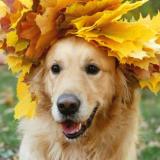
My Senecio Vitalis (Blue Chalk Fingers) plant keeps having limbs shrivel and die! Please help! I keep it out of direct sunlight and only water it every 3 to 4 days depending on need. I just separated the roots of the two plants and repoted a week ago.
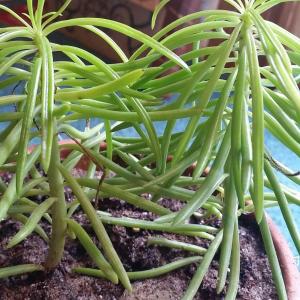

0
0
sunnyzou:maybe you hurt the roots when you repotting. no direct sunlight until they recovered growth.
Ueca:I know this sounds somewhat counter-intuitive, but try giving it a bit more sunlight.
文章
Dummer. ゛☀
2017年09月15日

Bright red, cream and dark blue coloured beetles, oval shaped and about 1cm long. They will be feeding or laying eggs on asparagus spears and fronds. Larvae are grey coloured hump-backed grubs with black heads and three pairs of short legs. They will usually be found feeding on the fronds. The tiny dark coloured eggs are laid pointing away from the plant tissue.
Plants affected
Asparagus
About Asparagus beetle
Adult asparagus beetles are up to 8mm long.
Adults appear in mid to late spring as asparagus spears are emerging through the soil.
They will mate and lay their dark coloured eggs in small rows on the spears.
When the eggs hatch the larvae will initially feed on the tips of spears, but later will migrate to the fronds.
They will feed for a few weeks before pupating in cocoons in the soil around the base of the plant or in nearby mulch.
There may be two or three generations per year depending on temperature and availability of food.
Adults will overwinter in the soil, leaf litter, or in hollow stems of asparagus plants.
Feeding by adults and larvae will cause yellow-brown discolouration of the leaves and stems.
Large infestations can completely defoliate and eventually kill plants.
Treatment
Chemical
Products containing the following chemical ingredients are all effective on Asparagus beetle
Pyrethrum
Note: It is important to read manufacturer's instructions for use and the associated safety data information before applying chemical treatments.
Organic
Regularly inspect plants and hand pick adults and larvae from the spears and fronds.
Remove old dead stems and dispose of them to prevent adults over-wintering.
Prevention
Inspect spears as soon as they emerge for adults mating and laying eggs.
Wipe away any eggs from the spears.
Remove any old plant debris around the base of plants to prevent larvae pupating.

Plants affected
Asparagus
About Asparagus beetle
Adult asparagus beetles are up to 8mm long.
Adults appear in mid to late spring as asparagus spears are emerging through the soil.
They will mate and lay their dark coloured eggs in small rows on the spears.
When the eggs hatch the larvae will initially feed on the tips of spears, but later will migrate to the fronds.
They will feed for a few weeks before pupating in cocoons in the soil around the base of the plant or in nearby mulch.
There may be two or three generations per year depending on temperature and availability of food.

Adults will overwinter in the soil, leaf litter, or in hollow stems of asparagus plants.
Feeding by adults and larvae will cause yellow-brown discolouration of the leaves and stems.
Large infestations can completely defoliate and eventually kill plants.
Treatment
Chemical
Products containing the following chemical ingredients are all effective on Asparagus beetle
Pyrethrum
Note: It is important to read manufacturer's instructions for use and the associated safety data information before applying chemical treatments.
Organic
Regularly inspect plants and hand pick adults and larvae from the spears and fronds.
Remove old dead stems and dispose of them to prevent adults over-wintering.

Prevention
Inspect spears as soon as they emerge for adults mating and laying eggs.
Wipe away any eggs from the spears.
Remove any old plant debris around the base of plants to prevent larvae pupating.
0
0
文章
Dummer. ゛☀
2017年09月15日

Long white, or occasionally blue-grey, waxy residues which look like cotton wool appear on the bark and branches especially around old pruning wounds. There may also be droplets of sticky, sugary honeydew on the bark which may become infected with black sooty mould. Cankers may also be present on aphid infested areas.
Plants affected
Apple, pear, prunus, crab apple, pyracantha, cotoneaster, elm, hawthorn and mountain ash trees.
About Apple woolly aphid
Adult aphids are up to 2mm long and elliptical in shape. They are pinkish-brown but their waxy coating gives them a white, woolly appearance.
This species does not overwinter as eggs but as young, under loose bark, or in cracks in bark or surface roots.
Young emerge in spring to re-establish the colony.
Aphids can give birth to as many as five live young a day so rapidly produce large colonies.
After a few generations, winged adults develop and move to new trees.
Colonies will develop around cracks and wounds in trees, as well as new shoots.
Feeding by apple woolly aphids will cause knobbly galls to form making the tree more susceptible to canker and other infections.
Aphids feed on plant sap and excrete plant sugars as honeydew.
Honeydew often covers the leaves of a plant and then becomes infested with unsightly black sooty moulds.
Treatment
Chemical
Products containing the following chemical ingredients are all effective on Apple woolly aphid
Pyrethroids and Pyrethrin
Note: It is important to read manufacturer's instructions for use and the associated safety data information before applying chemical treatments.
Organic
Check tree shoots and bark regularly for signs of woolly aphid.
Scrub areas within easy reach with a brush and a bucket of soapy water.
Spray infested areas with a firm jet of water to help reduce aphid numbers.
Spray with natural fatty acids such as an insecticidal soap.
The parasitic wasp Aphelinus mali will attack aphids above ground level.
Aphid predators such as ladybirds, aphidoletes, hoverflies, and lacewing larvae can be encouraged by providing suitable overwintering sites and by growing flowers which attract them.
Prevention
Regularly check plants for signs of infestation and deal with them as soon as they appear.
Encourage natural enemies like ladybirds, hoverflies and lacewings to become established in the garden by planting daisy-like flowers, yellow flowers and in particular, the poached egg plant Limnanthes douglasii.
Avoid using broad spectrum insecticides which will kill beneficial insects as well as aphids.
Encourage insect-eating birds such as blue tits, by hanging feeders in winter and nest boxes in spring.
If planting new apple trees, use rootstocks which are resistant to apple woolly aphid.
Paint pruning wounds with a tree coating composition to help prevent infestations establishing.

Plants affected
Apple, pear, prunus, crab apple, pyracantha, cotoneaster, elm, hawthorn and mountain ash trees.
About Apple woolly aphid
Adult aphids are up to 2mm long and elliptical in shape. They are pinkish-brown but their waxy coating gives them a white, woolly appearance.
This species does not overwinter as eggs but as young, under loose bark, or in cracks in bark or surface roots.
Young emerge in spring to re-establish the colony.
Aphids can give birth to as many as five live young a day so rapidly produce large colonies.
After a few generations, winged adults develop and move to new trees.

Colonies will develop around cracks and wounds in trees, as well as new shoots.
Feeding by apple woolly aphids will cause knobbly galls to form making the tree more susceptible to canker and other infections.
Aphids feed on plant sap and excrete plant sugars as honeydew.
Honeydew often covers the leaves of a plant and then becomes infested with unsightly black sooty moulds.
Treatment
Chemical
Products containing the following chemical ingredients are all effective on Apple woolly aphid
Pyrethroids and Pyrethrin
Note: It is important to read manufacturer's instructions for use and the associated safety data information before applying chemical treatments.

Organic
Check tree shoots and bark regularly for signs of woolly aphid.
Scrub areas within easy reach with a brush and a bucket of soapy water.
Spray infested areas with a firm jet of water to help reduce aphid numbers.
Spray with natural fatty acids such as an insecticidal soap.
The parasitic wasp Aphelinus mali will attack aphids above ground level.
Aphid predators such as ladybirds, aphidoletes, hoverflies, and lacewing larvae can be encouraged by providing suitable overwintering sites and by growing flowers which attract them.

Prevention
Regularly check plants for signs of infestation and deal with them as soon as they appear.
Encourage natural enemies like ladybirds, hoverflies and lacewings to become established in the garden by planting daisy-like flowers, yellow flowers and in particular, the poached egg plant Limnanthes douglasii.
Avoid using broad spectrum insecticides which will kill beneficial insects as well as aphids.
Encourage insect-eating birds such as blue tits, by hanging feeders in winter and nest boxes in spring.

If planting new apple trees, use rootstocks which are resistant to apple woolly aphid.
Paint pruning wounds with a tree coating composition to help prevent infestations establishing.
0
0



